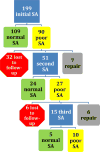The natural history of semen parameters in untreated asymptomatic adolescent varicocele patients: A retrospective cohort study
- PMID: 27815047
- PMCID: PMC5453725
- DOI: 10.1016/j.jpurol.2016.09.008
The natural history of semen parameters in untreated asymptomatic adolescent varicocele patients: A retrospective cohort study
Abstract
Introduction: Adolescent males with varicoceles present a dilemma for surveillance and treatment. Testicular volumetrics have not been shown to predict SA outcomes. Serial SAs are thus recommended in asymptomatic adolescent males with varicoceles and normal testicular development, but the natural history of semen parameters is unknown.
Objective: To explore the natural history of semen parameters in adolescent boys with a left varicocele under active surveillance.
Study design: Adolescents with an asymptomatic unilateral left varicocele, Tanner V development, normal testicular volumes, and an initial SA were retrospectively reviewed in a single-institution prospectively followed cohort. Total motile count (TMC) was calculated. A cutoff of TMC Z 20 million was used to dichotomize SA results into "normal" or "poor." Those with poor SA were offered repeat SA. Cumulative probabilities of normal TMC over successive rounds of SA were calculated. Bivariate models were used to explore associations of a second consecutive poor TMC with age and varicocele grade.
Results: A total of 216 patients provided an initial SA between 1992 and 2015. We excluded 17 for a history of cryptorchidism or incomplete SA data for a final cohort of 199 patients with median follow-up of 3.3 years (interquartile range 1.5-5.6 years). The mean age at initial SA was 17.9 years (range 14.8-21.8 years). One hundred and nine out of 199 had an initial normal TMC. Of the 90 out of 199 with an initially poor TMC, 51 had repeat SA and 24 of the 51 patients improved to normal TMC. Of the 27 patients with two consecutive poor TMCs, 15 had a third SA and five out of 15 improved to normal TMC. Thus, cumulatively, 55%, 67%, and 69% of all patients had a normal TMC after an initial, second, and third SA, respectively. However, fewer patients in each round of SA normalized their TMC (Figure). Neither age nor varicocele grade was associated with a second consecutive poor TMC.
Discussion: Two-thirds of Tanner V boys with an uncorrected varicocele and normal testicular volumes achieve a normal TMC regardless of varicocele grade or age. Despite Tanner V development, 47% with an initial "poor" SA will improve to normal status without surgery. However, a small subgroup of patients will have persistently poor TMC and thus should be targeted in future research for timely intervention.
Conclusion: Semen parameters improve over time. SA should be followed and repeated at least once in symptomatic Tanner V boys with varicoceles.
Keywords: Adolescent varicocele; Natural history; Semen analysis; Total motile count.
Copyright © 2016 Journal of Pediatric Urology Company. Published by Elsevier Ltd. All rights reserved.
Conflict of interest statement
None.
Figures
Comment in
-
Featuring: Asymptomatic adolescent varicoceles.J Pediatr Urol. 2017 Jun;13(3):246-247. doi: 10.1016/j.jpurol.2017.05.010. J Pediatr Urol. 2017. PMID: 28645617 No abstract available.
References
-
- Kolon TF. Evaluation and management of the adolescent varicocele. J Urol. 2015;194:1194–201. - PubMed
-
- Bogaert G, Orye C, De Win G. Pubertal screening and treatment for varicocele do not improve chance of paternity as adult. J Urol. 2013;189:2298–303. - PubMed
-
- Baazeem A, Belzile E, Ciampi A, Dohle G, Jarvi K, Salonia A, et al. Varicocele and male factor infertility treatment: a new meta-analysis and review of the role of varicocele repair. Eur Urol. 2011;60:796–808. - PubMed
-
- Abdel-Meguid TA, Al-Sayyad A, Tayib A, Farsi HM. Does varicocele repair improve male infertility? An evidence-based perspective from a randomized, controlled trial. Eur Urol. 2011;59:455–61. - PubMed
-
- Nork JJ, Berger JH, Crain DS, Christman MS. Youth varicocele and varicocele treatment: a meta-analysis of semen outcomes. Fertil Steril. 2014;102:381–387.e6. - PubMed
Publication types
MeSH terms
Grants and funding
LinkOut - more resources
Full Text Sources
Other Literature Sources



